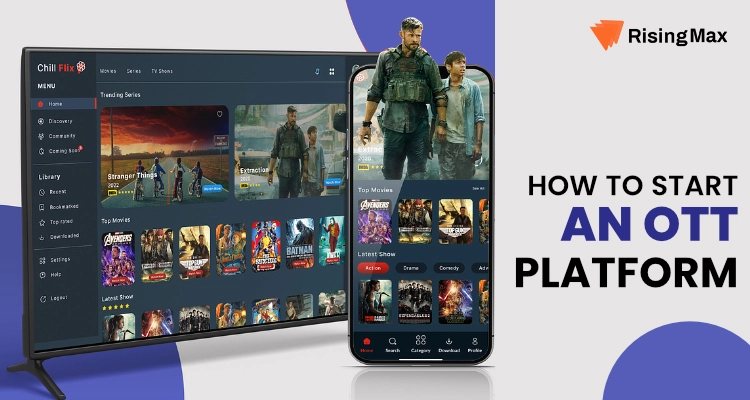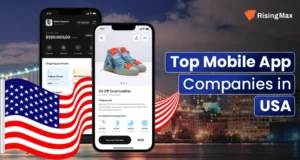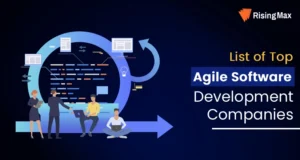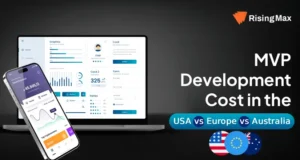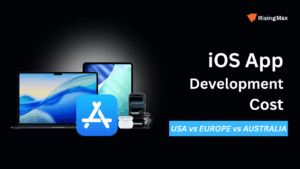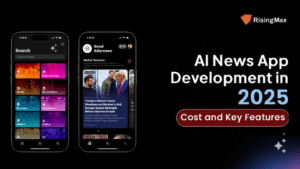In the last few years, we have seen immense growth in the popularity of OTT platforms. As technology advances, many renowned OTT platforms have transformed their ways of delivering plenty of high-quality content to users. With this transformation, users can easily access media content anywhere and anytime. The increasing revenue growth of these platforms motivates business enthusiasts like you to enter this booming sector and create your own OTT platform.

If you’re considering entering the OTT market and building your own platform, you’re in the right place. We will walk you through the process of starting an OTT platform, from understanding the market trends to implementing the necessary technologies.
Let’s dive in and explore how you can create your successful OTT platform.
Understanding The OTT Market
Before going into the details of building an OTT platform, it’s essential to understand the current state and trends of the OTT market. The market for OTT video streaming is experiencing tremendous growth, with revenues projected to reach $316 billion by the end of this year. This growth is driven by the increasing number of viewers subscribing to OTT services, with over two billion people expected to use subscription-based OTT services in the coming years.
What OTT Platform Market Brings To The Table?
As per the reports of Statista,
- By 2024, it is anticipated that the global OTT Video industry will generate US$325.40 billion in sales.
- By 2028, the market is predicted to have grown at a compound annual growth rate (CAGR) of 6.58%, with a projected value of US $419.90 billion.
- OTT Video Advertising is the biggest market category in the OTT Video market, with a projected market value of US $191.30 billion by 2024.
- The United States is expected to create the most revenue in 2024; US $140,700.00 million, when compared to other nations.
- The OTT Video market is projected to have about 4.4 billion users by 2028 in terms of actual numbers.
- The user penetration rate of OTT platforms is projected to be 54.7% by 2028.
Why To Create An OTT Platform?
The popularity of OTT platforms like Netflix, Disney+, Hulu, and Amazon Prime Video demonstrates the immense potential and opportunities in the OTT industry. By creating your own OTT platform, you can reap several benefits, including:
User-Friendly Features
OTT platforms offer on-demand content, allowing users to watch what they want, when they want. This flexibility and convenience are highly appealing to viewers.
Adjustable Pricing
Unlike traditional TV platforms, OTT applications often employ subscription-based revenue models, allowing users to pay for content on a recurring basis or through one-time purchases.
Variety of Content
OTT platforms offer a vast range of content, including TV series, movies, documentaries, and more. This diverse content library caters to a wide range of user interests.
Ease of Accessibility
OTT applications are accessible on various devices, such as smartphones, Smart TVs, and web platforms, enabling users to enjoy their favorite content anytime, anywhere.
Are you prepared to transform your vision of launching an immersive OTT platform into a reality?
Our team of skilled developers are here to guide you through the entire process, ensuring that your platform stands out from the competition.
How To Build An OTT Platform?
Now that you understand why you need to build an OTT platform let’s explore the step-by-step process to help you successfully create your own:
Market Research & Target Audience Analysis
Before venturing on your OTT platform journey, conducting thorough market research and analyzing your target audience is crucial. Identify the genre or niche that aligns with your content offerings, and study your potential viewers’ preferences and viewing habits. This research will help you create a platform that caters to their needs and interests.
Content Acquisition & Licensing
To establish a successful OTT platform, you need engaging and high-quality content. Acquire the necessary licenses and permissions to host and distribute the content on your platform. Build partnerships with content creators, production houses, and distributors to ensure a diverse and captivating content library.
Choose A Monetization Model
Select a monetization model that aligns with your business goals and decides how your OTT platform will make money for you. Common options include subscription-based models (SVOD), pay-per-view models (TVOD), and ad-supported models (AVOD). Consider your target audience, content offerings, and revenue expectations when choosing the right monetization strategy for your OTT platform.
Develop The OTT Platform
Begin the development process by choosing the appropriate technology stack for your OTT platform. Consider factors such as scalability, performance, and cross-platform compatibility. Utilize technologies like cloud hosting, efficient servers, streaming protocols, content delivery networks (CDNs), and robust security measures to ensure a seamless and secure user experience.
Design User Interface & User Experience (UI/UX)
Create an intuitive and visually appealing user interface (UI) that enhances the user experience (UX). Focus on easy navigation, personalized recommendations, and engaging visuals to keep users hooked to your platform. Consider implementing features like user profiles, smart search options, favorite lists, and category-based content distribution to improve user engagement and satisfaction.
Implement Payment Gateway Integration
Integrate a secure and reliable payment gateway to enable smooth transactions and subscription management on your OTT platform. Offer multiple payment options to cater to different user preferences and ensure a seamless user journey from content discovery to payment completion.
Testing & Quality Assurance
Thoroughly test your OTT platform for functionality, performance, and user experience. Conduct comprehensive quality assurance (QA) testing to identify and resolve any bugs, glitches, or usability issues. This step is crucial to ensure a seamless and error-free user experience.
Launch & Promote Your OTT Platform
Once you’re satisfied with the development and testing of your OTT platform, it’s time to launch it in the market. Develop a comprehensive marketing strategy to promote your platform and attract users. Utilize various channels, such as social media, content marketing, influencer collaborations, and targeted advertising, to generate awareness and drive user acquisition.
Analyze User Data & Optimize
Continuously monitor and analyze user data to gain insights into user behavior, preferences, and engagement patterns. Leverage analytics tools to track key metrics like viewership, retention rates, and revenue generation. Use this data to optimize your platform, improve content recommendations, and enhance the overall user experience.
Distinct Types Of OTT Platform Monetization Models
Monetization is a crucial aspect of OTT platforms, and there are several models through which they can generate revenue. Understanding these monetization models allows OTT platforms to choose the approach that best aligns with their content strategy, audience preferences, and revenue goals.
Subscription-Based Models (SVOD)
Subscription Video on Demand (SVOD) is a popular monetization model used by OTT platforms. It involves offering users access to a library of content for a recurring fee. Key points include:
Recurring Revenue: SVOD models provide a predictable stream of revenue, as users pay a regular subscription fee, typically monthly or annually.
Content Access: Subscribers can access the platform’s content library, including movies, TV shows, and original productions.
Diverse Subscription Tiers: Platforms often offer different subscription tiers with varied features and content access, catering to different user preferences and budgets.
User Retention: SVOD models focus on retaining subscribers by consistently offering new and engaging content to justify the recurring subscription fee.
Pay-Per-View Models (TVOD)
Transactional Video on Demand (TVOD) allows users to pay for individual pieces of content on a one-time basis. Key points include:
Content Flexibility: Users have the flexibility to pay for specific movies, events, or premium content they are interested in without committing to a recurring subscription.
Individual Revenue Generation: Each transaction generates revenue for the platform, and users pay for content on a per-view basis.
Event-Based Content: TVOD is often used for special events, such as live sports events or exclusive premieres, where users pay to access the content for a limited time.
No Subscription Commitment: Users can engage with content as and when they choose without being tied to a subscription plan.
Ad-Supported Models (AVOD)
Ad-Supported Video on Demand (AVOD) is a monetization model where users access content for free, supported by advertisements. Key points include:
Free Access to Content: Users can access a wide range of content without paying a subscription fee, as the platform generates revenue through advertising.
Targeted Advertising: AVOD platforms can leverage user data to deliver targeted advertisements, enhancing the value for advertisers and potentially increasing ad revenue.
Content Monetization: Advertisements are strategically placed within the content, and the platform earns revenue based on ad views, clicks, or other engagement metrics.
User Engagement: AVOD models aim to balance user experience with ad exposure, ensuring that ads do not disrupt the viewing experience while still generating revenue.
If you already have an idea about creating an OTT platform, Schedule a call and we’ll help you implement it!
What Is The Cost To Make An OTT Platform?
Developing an OTT platform involves various cost considerations, and it’s essential to carefully assess the requirements and budget before venturing on the development journey. Whether opting for a custom-built solution or leveraging existing OTT frameworks, businesses should prioritize creating an engaging user experience while balancing the associated expenses.
The costs of developing an OTT platform can vary widely, but here are some rough estimates based on industry averages:
Basic OTT Platform: A simple OTT platform with standard features may cost anywhere between $25000 to $50000 for initial development.
Custom OTT Platform: Building a custom OTT platform with advanced features and bespoke design can range from $50000 to several more dollars, depending on the complexity and scale.
It’s important to note that these figures are general estimates, and the actual cost of developing an OTT platform can fluctuate based on the specific requirements, chosen development team, geographical location, and other influencing factors.
Closure
Building an OTT platform requires careful planning, market research, and execution. By following the step-by-step process outlined in this guide, you can create a successful OTT platform that caters to your target audience’s needs and preferences. Adopt the benefits of OTT platforms, leverage the latest technologies, and deliver high-quality content to captivate and engage your viewers. With the right strategy and execution, your OTT platform can become a profitable and thriving business in the ever-growing digital streaming industry.
If you have an idea about how to create an OTT platform, contact the prominent OTT app development company to give your ideas a new life. Contact RisingMax’s experts to discuss your business requirements and have a handshake deal.

